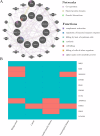Uncovering drug targets for cluster headache through proteome-wide Mendelian randomization analysis
- PMID: 40114078
- PMCID: PMC11924832
- DOI: 10.1186/s10194-025-01999-0
Uncovering drug targets for cluster headache through proteome-wide Mendelian randomization analysis
Erratum in
-
Correction: Uncovering drug targets for cluster headache through proteome-wide Mendelian randomization analysis.J Headache Pain. 2025 Apr 29;26(1):94. doi: 10.1186/s10194-025-02032-0. J Headache Pain. 2025. PMID: 40301708 Free PMC article. No abstract available.
Abstract
Background: Cluster headache (CH) is a highly disabling primary headache disorder with a complex underlying mechanism. However, there are currently no effective targeted therapeutic drugs available. Existing medications often have limited efficacy and numerous side effects, which frequently fail to meet clinical needs. This study aims to identify potential new therapeutic targets for CH through proteome-wide mendelian randomization (PWMR).
Methods: We used PWMR to estimate the causal effects of plasma proteins on CH. This analysis integrated plasma protein quantitative trait loci (pQTL) data with genome-wide association study (GWAS) results of CH phenotypes. In addition, we conducted various sensitivity analyses, enrichment analyses, phenome-wide MR assessments, protein-protein interaction network construction, and mediation MR analyses to further validate the drug potential of the identified protein targets.
Results: We identified 11 protein targets for CH (p < 2.41 × 10-5), with high-priority candidates exhibiting minimal side effects. Phenome-wide MR revealed novel targets-PXDNL, CCN4, PKD1, LGALS9, and MRC1-that show no significant disease-related adverse effects and interact with established preventive CH drug targets. Notably, PXDNL interacts with both acute and preventive CH drug targets. Furthermore, the causal effect of plasma proteins on CH is partially mediated by cortical surface area, with mediation proportions ranging from 3.2% to 10.0%.
Conclusions: We identified a set of potential protein targets for CH, characterized by rare side effects and a strong association with the biological mechanisms underlying the disorder. These findings offer valuable insights for the development of targeted drug therapies in the treatment of CH.
Keywords: Cluster headache; Drug targets; Mendelian randomization; Proteomics.
© 2025. The Author(s).
Conflict of interest statement
Declarations. Ethics approval and consent to participate: Not applicable. Consent for publication: Not applicable. Competing interests: The authors declare no competing interests.
Figures





References
-
- May A, Schwedt TJ, Magis D et al (2018) Cluster headache. Nat Rev Dis Primers 4:18006 - PubMed
-
- Headache Classification Committee of the International Headache Society (IHS) (2018) The international classification of headache disorders, 3rd edition. Cephalalgia 38:1–211 - PubMed
-
- Geerlings RP, Haane DY, Koehler PJ (2011) Rebound following oxygen therapy in cluster headache. Cephalalgia 31:1145–1149 - PubMed
-
- Petersen AS, Lund N, Jensen RH et al (2021) Real-life treatment of cluster headache in a tertiary headache center - results from the Danish Cluster Headache Survey. Cephalalgia 41:525–534 - PubMed
MeSH terms
Substances
LinkOut - more resources
Full Text Sources
Research Materials
Miscellaneous

